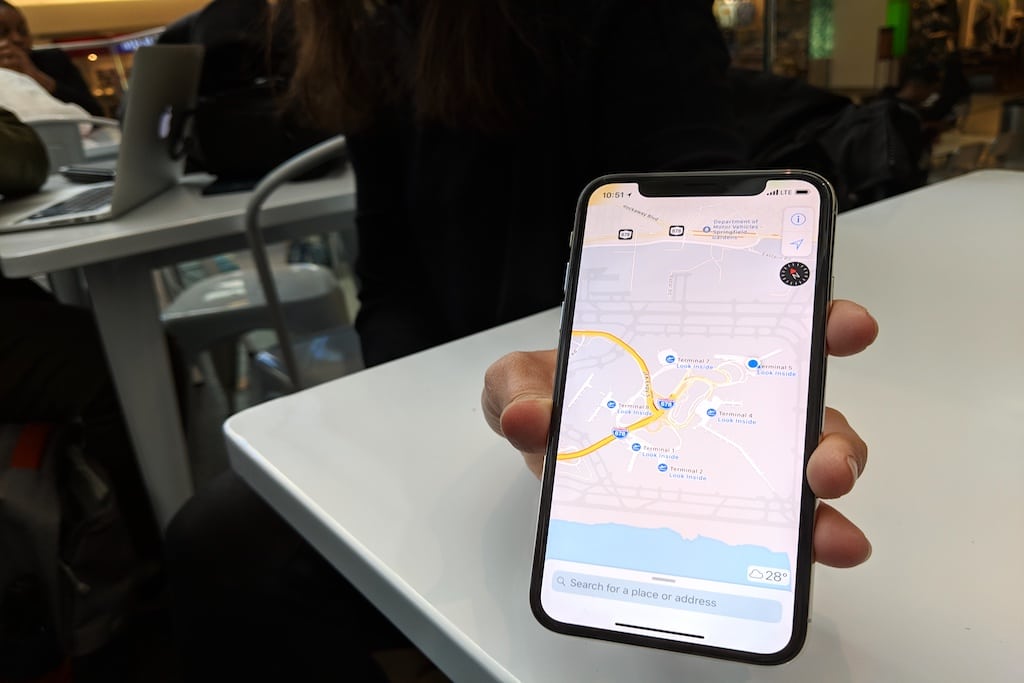Skift Take
Built-in maps of airport terminals are certainly useful for iPhone users. But this new feature has a long way to go in terms of airports included and the granularity of information available, before it becomes a mainstay for frequent travelers.
iPhone apps are a core part of today’s travel industry, but Apple itself hasn’t yet exercised its travel gene in a big way.
For many reasons, finding out precise information about where to eat or shop when you’re stuck in an airport terminal remains a hassle. Now, Apple wants to fix that by building airport maps into each of its devices.
It’s not a killer travel app by any means, but it is dipping its toe in the water.
Apple has added airport terminal maps, featuring check-in locations, dining options, and shopping outlets, into its Apple Maps app in iOS 11 as part of a new indoor maps feature.
The feature emerged quietly this summer as part of the iOS 11 beta and 34 airports around the world are being rolled out in the new feature, including airports in the U.S, UK, Switzerland, Canada, and Germany. The update also adds navigation and accessibility information, showing icons for things like elevators and bathrooms.
Instead of using GPS technology, which is spotty in airports, Apple Maps instead passively connects to Wi-Fi hotspots to figure out a user’s location and where they’re looking. Users don’t need to be connected to Wi-Fi for this geolocation feature to function, and it’s able to figure out what level of the terminal the user is on to prevent confusion.
Apple Maps is the most popular maps app in the iOS ecosystem, and the upgrade to airport information outstrips the capability of top competitor Google Maps.
The information isn’t perfect, though; it doesn’t list electrical outlet locations around a terminal and may miss certain kiosks or vending machines. During a walkthrough demonstrating the technology at JFK International Airport in New York City, for instance, Apple Maps showed the location of a cosmetics vending machine but did not show an icon for the electronics vending machine directly next to it.
It also can’t tell you how long it will take to walk to the Shake Shack all the way at the other end of the terminal to grab a burger before your flight.
A map of the baggage claim at JFK did not have each carousel numbered, while O’Hare International Airport did. The lack of standardization stems from the manner in which Apple works with airports to add this functionality to the app.
The granularity of the information depends on the airport, and will only improve over time, according to Apple representatives.
Users can report incorrect or missing information to the Apple Maps team, which can fix problems within days. The Apple Maps app already integrates with services like Uber and Lyft, along with Yelp for restaurant reviews.
Airports and airlines have toyed with interactive digital maps for years, but most don’t offer them due to the cost and complexity of creating them. Apple is working with airports around the world, but now only offers one Asian airport (Hong Kong).
Airlines are likely excited about the prospect of a third-party solution to make the airport experience easier for their customers.
“We’ve done some experimentation to adding maps within our app, but it’s cost prohibitive to add all our airports,” said Morgan Johnston, manager of corproate communications for JetBlue. “Seeing Apple jump into the space is a huge opportunity to heighten our integration.”
The Daily Newsletter
Our daily coverage of the global travel industry. Written by editors and analysts from across Skift’s brands.
Have a confidential tip for Skift? Get in touch
Tags: apple, apple maps, maps, mobile
Photo credit: An Apple representative shows off the new indoor maps feature in Terminal 5 at JFK International Airport. Skift
